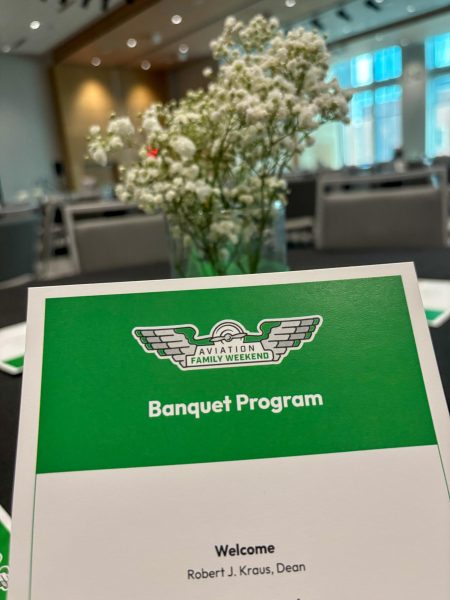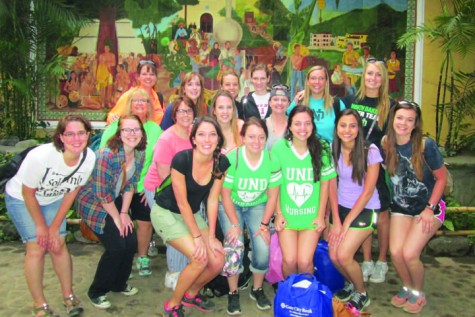Studio One: Not just TV anymore
Studio One Cast Eirik Nilssen (left) and Bratli Marty Mueller (right) behind the scenes for their weekly live show. Photo by Nickolas Nelson/The Dakota Student.
This week, Studio One airs its 515th show.
Spawning from a student’s idea in 1987, UND’s television news program had its humble beginnings in the basement of Roberston Hall. Ten years later, the production relocated to its current building, the Skalicky Tech Incubator and has been cranking out weekly shows since.
With nearly one thousand interns passing through in the groups history, Studio One is an opportunity for students to get a hands-on look at the world of television production.
The Studio One team not only consists of student interns but also a fulltime staff of eight. The staff works with the students to put each week’s show together — teaching and mentoring them every step of the way.
Marketing Director Stephanie Flyger said every day is different, and there is always something to be done at Studio One. Flyger has been with the program for almost nine years, with her first two as an intern while going to school at UND.
Monte Koshel is another staff member who began as an intern. Koshel has enjoyed watching the program grow through his many years of involvement.
“That’s the reason I’ve been here so long,” Koshel said. “Because we’re constantly trying to improve the student experience.”
Koshel went on to describe how students are trying to balance school with jobs and other activities. Studio One operates on a flexible basis of working around its intern’s schedules.
The interns at Studio One are divided into several teams: marketing, weather, news, graphics and production.
Eirik Nilssen Bratli works as the student director for Studio One on show days, and a video journalist during the week. He is currently in his third semester as an intern, his final before he graduates in May.
He notes how Studio One has opened doors to make sure he is prepared for what comes after graduation, and the level of professionalism practiced each day he has been with the program.
“It’s a mentality that you need (to have) to go into the workforce,” Nilssen Bratli said. “More and more employers are looking for people who are responsible, professional and know how to communicate, and a lot of those skills we learn here.”
In addition to professional, communication and teamwork skills, Studio One also teaches its interns technical skills in managing and operating the hundreds of thousands of dollars worth of video and computer equipment available to them.
Nilssen Bratli describes his experience at Studio One as crucial to his future.
“Before I came here, I didn’t really know what I was going to do with my life work-wise,” Nilssen Bratli said. “The three semesters here have really been the best I could ask for. It has really set me on a course for the rest of my life.”w
Studio One is open to any student interested in an internship. Although the positions involve tasks mostly related to communication and marketing, the program has seen interns from many disciplines, including nursing, English and aviation. No previous television experience is required from interns, and skills are taught on the job by the staff mentors.
Alex Aman, working as a video journalist for Studio One, is a fisheries and wildlife major and encourages students to look into the benefits that are possible with a Studio One internship.
Aman applied based on an interest in working with cameras and people and is greatly enjoying his time with the program.
“I think Studio One is an extremely great opportunity that a lot of students may not know about,” Aman said. “It has already opened a lot of doors for me. I’ve made a lot of valuable connections to my future.”
Studio One extends far beyond the UND campus. The show broadcasts to the Grand Cities, Michigan, Colorado and Wisconsin, just to name a few.
“We take UND stories, and we tell these stories knowing that they’ll be seen by people outside our community,” Koshel said. “It’s such a great way to get this UND content out to these different places. It really is a wonderful way to market the university through our program.”
Studio One episodes are available to watch live each week, but are also available online and via social media. The staff who have been with the program through the years have been witness to the rapid change of technology and are constantly working to adapt.
“It’s a really fun way that media has exploded,” Koshel said. “It’s not just TV anymore.”
“We have this network of people all around the country,” Director of Television and Radio Barry Brode said, who has been with Studio One since the beginning. “When we started the program 25 years ago, we never anticipated the alumni network that would form,” Brode said on the Studio One website. “Now, with so many of our alumni in hiring positions, it’s a great opportunity for our interns to connect with them.”
For anyone curious to see how it all comes together, Studio One provides an opportunity for an interactive experience.
To watch a Studio One show firsthand, tickets are available to be a part of their live studio audience during each weekly show.
Along with watching the show live, audience members get a short history lesson on the program, as well as a behind the scenes tour of the facility where interns are in action preparing for the evening’s episode.
“Just today (and how long have I been here, right?), I was standing out in this hallway watching them do their thing and I thought, “That’s pretty amazing’,” Koshel reflects. “They can do great things, you just have to power them to do that.”
Studio One airs every Thursday at 5 p.m., with a tour beginning at 4:30 p.m. for its live studio audience. For more information on internships, the production or tickets to an upcoming show, please visit studio1.und.edu.
Serianna Henkel is a staff writer for The Dakota Student. She can be reached at serianna.henkel@my.und.edu.











